
News |
- Real Value of Canada's Boreal - $93 Billion
- Canadians Toxic, Malathion in Manitoba Samples
- Will Canada Move Beyond Kyoto?
- Arctic Oil Drilling Halted
- Devils Lake Study - Manitoba Vindication
- CEOs Demand Climate Change Action
- Proposed Changes in Nopiming Park
- Round Table Says 'Safeguard Boreal Regions'
- Climate Change Day of Action December 3, 2005
- Scientists' Plan to Save World's Oceans
- Manitoba Wildlands Releases 2005 Audit
- Groups Expose Hidden Road Network
| Real Value of Canada's Boreal - $93 Billion | 29 November 05 |
 The clean water and stable climate provided by Canada's boreal forests are worth billions of dollars to the Canadian economy, says a new report. Counting Canada's Natural Capital puts a financial value on what forests and wetlands do for the environment, including purifying water, regulating climate and producing oxygen. The study found that the boreal forest works as a massive carbon sink. It stores an estimated 67 billion tonnes of carbon - 303 years of Canada's total 2002 carbon emissions. Researchers said the boreal forest could be looked at like a "carbon bank account" worth $3.1-trillion (U.S.). The clean water and stable climate provided by Canada's boreal forests are worth billions of dollars to the Canadian economy, says a new report. Counting Canada's Natural Capital puts a financial value on what forests and wetlands do for the environment, including purifying water, regulating climate and producing oxygen. The study found that the boreal forest works as a massive carbon sink. It stores an estimated 67 billion tonnes of carbon - 303 years of Canada's total 2002 carbon emissions. Researchers said the boreal forest could be looked at like a "carbon bank account" worth $3.1-trillion (U.S.).The report, commissioned by the Canadian Boreal Initiative and written by the Pembina Institute, estimates services from Canada's boreal forests, which reach from Yukon to the Eastern Seaboard, have a value of $93.2 billion annually - about twice the total market value of forestry, hydro and oil and natural gas activity. The report recommends governments carefully weigh the value of industrial activity against long-term damage to the boreal forest. That should lead governments to expand the number and size of protected forested areas - especially in light of the growing number of resource extraction projects planned or underway in Canada. "I think we are getting close to the line," said David Schindler, a University of Alberta ecology professor and consultant on the report. Prof. Schindler said the value of boreal "natural capital" must be considered whenever resource projects are contemplated in the boreal forest region. "What it's saying is, 'Look at these values before you turn the forest into another pile of logs and sell it.'" He hopes the report will change the way politicians, industry leaders and the public think about the boreal forest. View the November 24, 2005 Canadian press article View the CBI report Counting Canada's Natural Capital: Assessing the Real Value of Canada's Boreal Ecosystem Services (PDF) View the November 25, 2005 CBI press release Sources: CBI, Canadian Press |
|
| Canadians Toxic, Malathion in Manitoba Samples | 29 November 05 |
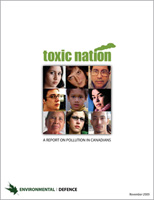 A cocktail of harmful toxic chemicals has been found inside every person tested in a Canada-wide study, released November 9, 2005 by Environmental Defence Canada. A cocktail of harmful toxic chemicals has been found inside every person tested in a Canada-wide study, released November 9, 2005 by Environmental Defence Canada.The environmental group tested the blood and urine of 11 volunteers from Salt Spring Island in British Columbia to St. John's in Newfoundland and Labrador for the presence of 88 chemicals - such as DDT, PCBs, stain repellants, flame retardants, mercury and lead. Merrill-Ann Phare, the only Manitoban among the 11 volunteers, had levels that were off the charts for two breakdown products of the malathion chemical family. The lawyer said she recalls mosquito-fogging trucks going through her St. Vital neighbourhood three times this summer. Toxic Nation: A Report on Pollution in Canadians calls on the federal government to ensure Canadians receive the same level of protection from toxic chemicals as Europeans and Americans, as both are on their way to being well ahead of Canada in regulating harmful chemicals. The release of the report also coincides with the mandated five-year review of Canada 's national pollution law - the Canadian Environmental Protection Act (CEPA). View the November 9, 2005 Environmental Defense press release View the November 10, 2005 Winnipeg Free Press article View the Environmental Defense report Toxic Nation: A Report on Pollution in Canadians Take the Chemical Reduction Pledge on the Toxic Nation web site Sources: Environmental Defense, Winnipeg Free Press |
|
| Will Canada Move Beyond Kyoto? | 24 November 05 |
 Canada needs to reduce greenhouse gas emissions 25 per cent below 1990 levels by 2020, and 80 per cent below 1990 levels by 2050 says a new report from the David Suzuki Foundation and the Pembina Institute. The November 22 report comes out just before Canada hosts the most important climate change conference since the Kyoto Protocol was adopted in 1997. Canada needs to reduce greenhouse gas emissions 25 per cent below 1990 levels by 2020, and 80 per cent below 1990 levels by 2050 says a new report from the David Suzuki Foundation and the Pembina Institute. The November 22 report comes out just before Canada hosts the most important climate change conference since the Kyoto Protocol was adopted in 1997. Canada's current Kyoto goal is to reduce emissions six per cent below 1990 levels by 2012. And unlike the European Union, Canada has no plan beyond 2012. The United Nations Climate Change Conference will be held in Montreal, November 28 to December 9. Ten thousand delegates from more than 189 countries are expected. The conference will consider what the world needs to do after the initial Kyoto targets expire in 2012. Dale Marshall of the David Suzuki Foundation told Manitoba Wildlands he hopes the Montreal conference will lead to a framework for international negotiations on post-2012 emission targets, and a firm timeline for those negotiations. Marshall says Canada's lack of long term goals and its poor domestic record on Kyoto (emissions are 24% above 1990 levels) are hurting its credibility in international negotiations. In addition to the timely report, the Suzuki Foundation will place billboards depicting dried-up versions of Canada's iconic landscapes around the conference center in Montreal. View the November 22, 2005 David Suzuki press release and report View the David Suzuki billboards View the UN Climate Change Conference website View the November 22, 2005 Manitoba Wildlands news item Sources: David Suzuki Foundation, Pembina Institute |
|
| Arctic Oil Drilling Halted | 24 November 05 |
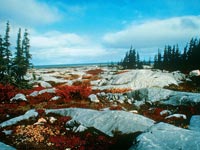 The ongoing debate, that started when it was first protected 25 years ago, over opening Alaska's Arctic National Wildlife Refuge (ANWR) to the oil industry has come to a head. Republicans dropped the ANWR drilling provision from a budget bill before the US House of Representatives, but the drama on Capitol Hill could heat up again. The ongoing debate, that started when it was first protected 25 years ago, over opening Alaska's Arctic National Wildlife Refuge (ANWR) to the oil industry has come to a head. Republicans dropped the ANWR drilling provision from a budget bill before the US House of Representatives, but the drama on Capitol Hill could heat up again. Earlier, the Senate approved a version of the budget bill that included ANWR drilling. But opposition from moderate Republicans prevented the bill from passing through the House with the ANWR provision included. "It was the kind of showdown at high noon that restores one's faith both in democracy and the sanctity of America's natural heritage," said Natural Resources Defense Council President John Adams. "Just one year ago, Washington insiders were saying that Arctic drilling was a done deal." President Bush has long insisted oil from ANWR is critical as America moves toward oil independence. But ExxonMobil CEO Lee Raymond says the concept of energy independence is unrealistic, and "a flawed notion when considering strategic priorities for the United States." A joint House-Senate conference committee will now draft a measure to take back to their respective chambers. Proponents of ANWR drilling may try to reintroduce the measure at that stage. The joint bill is expected in December. The US House of Representatives has passed authorization five times in various forms that would allow drilling in the refuge, but each time the measure has died in the Senate. View the Map of ANWR (PDF) View the November 10, 2005 Washington Post article View the November 15, 2005 Guardian article View the November 10, 2005 NRDC President John Adams' comments View the 2005 ExxonMobil CEO, Lee Raymond interview View the CBC feature - INDEPTH: OIL Oil and the Arctic National Wildlife Refuge Sources: Washington Post, NRDC, The Guardian, ExxonMobil |
|
| Devils Lake Study - Manitoba Vindication | 22 November 05 |
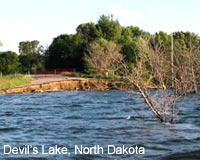 The joint study agreed to by North Dakota to allay Canadian concerns regarding invasive species and foreign biota flowing from Devils Lake north to Lake Winnipeg was released November 15, 2005. The joint study agreed to by North Dakota to allay Canadian concerns regarding invasive species and foreign biota flowing from Devils Lake north to Lake Winnipeg was released November 15, 2005.Both Manitoba and North Dakota claim the study vindicates their position. The Governor of North Dakota stated the results prove water from Devils Lake does not pose a threat to Manitoba waterways, as none of the 12 invasive species Manitoba identified as being of concern were found in Devils Lake. The tests did however, reveal biota of potential concern not previously found in Lake Winnipeg, causing Manitoba Water Stewardship Minister Steve Ashton to assert that "These findings underscore the importance of the August 5 agreement between Canada and the U.S., which provides for mitigation should potentially risky biota be discovered. The test results also point to the need to move quickly on the agreement to build a more advanced, permanent barrier at the outlet." Four types of blue-green algae, that are not found in Lake Winnipeg, were identified in Devils Lake. These algae are potential species of concern as they are capable of producing toxins. Three fish parasites not known to be present in Lake Winnipeg or the Hudson Bay basin which have the capability to impact fish, were also found. Minister Ashton also said that Manitoba will now move to pressure the Canadian government to expedite negotiations with the US to build a permanent filter. View the November 15, 2005 Manitoba Water Stewardship press release View the November 16, 2005 Governor of North Dakota press release View the White House's Council on Environmental Quality report Survey of Specific Fish Pathogens in Free-Ranging Fish from Devils Lake (PDF) View the November 15, 2005 Winnipeg Free Press article (DOC) View the November 16, 2005 Winnipeg Free Press article (DOC) Sources: Government of Manitoba, Governor of North Dakota, Winnipeg Free Press |
|
| CEOs Demand Climate Change Action | 22 November 05 |
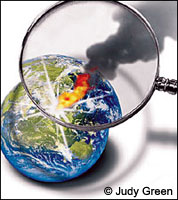 Stronger action to fight climate change is the message issued by some of Canada's most influential corporate heads. In a letter to Prime Minister Paul Martin the CEOs urge the extension of Canada's climate-change plan beyond the 2008-2012 time frame of the Kyoto protocol. Stronger action to fight climate change is the message issued by some of Canada's most influential corporate heads. In a letter to Prime Minister Paul Martin the CEOs urge the extension of Canada's climate-change plan beyond the 2008-2012 time frame of the Kyoto protocol.On October 7, 2005, the Executive Forum on Climate Change was asked by Prime Minister Paul Martin to provide the Government of Canada advice on how to move forward in climate change negotiations in Canada and internationally. In their November 17, 2005 letter, the CEOs acknowledge the seriousness of human health, security and environmental risks resulting from existing and future climate change; the shared responsibility of governments, corporations, consumers and citizens under the Kyoto Protocol; and the need for significant action to be taken. The corporate leaders say a strong response to the evidence in the scientific assessments of the UN International Panel on Climate Change (IPCC) is required. They are also looking for policy certainty to guide action post-2012. Led by the Canadian Centre for Policy Ingenuity (CCPI) and Alcan Inc., the Executive Forum on Climate Change was launched to build on the G8 process and provide business perspectives on climate change in the lead-up to the UN Conference on Climate Change in Montreal. View the November 17, 2005 press release from the Executive Forum on Climate Change View the November 17, 2005 Letter from the Executive Forum on Climate Change Visit the Executive Forum on Climate Change View the November 17, 2005 statement from Canadian business/industry leaders View the November 17, 2005 Canadian Press article on CBC.ca Sources: Executive Forum on Climate Change, Canadian Press |
|
| Proposed Changes in Nopiming Park | 17 November 05 |
 The Manitoba Parks Branch is asking Manitobans to provide feedback on proposed changes to the Land Use Classification (LUC) of a portion of Nopiming Provincial Park, located on the east side of the province, along the Ontario-Manitoba border. The Manitoba Parks Branch is asking Manitobans to provide feedback on proposed changes to the Land Use Classification (LUC) of a portion of Nopiming Provincial Park, located on the east side of the province, along the Ontario-Manitoba border.The public consultation includes open houses on November 8th in Winnipeg and November 9th in Pine Falls. Information is posted on the Manitoba Conservation web site. A LUC change from recreational development to backcountry for an area within the park is proposed. Backcountry is a protected lands classification. The change would protect a rare landscape feature and its associated ecosystem, protecting it from logging and mining, as well as hydro, petroleum, and other activities that significantly and adversely affect habitat. Public comments will be accepted until November 30, 2005. Comments can be mailed, faxed or e-mailed to Manitoba Conservation (see links below). View the Manitoba Parks Branch Consultations page for information on the proposed change for Nopiming Provincial Park View background information on the LUC change for Nopiming Provincial Park (PDF) Source: Government of Manitoba |
|
| Round Table Says 'Safeguard Boreal Regions' | 16 November 05 |
 Canada's National Round Table on the Environment and the Economy (NRTEE) concludes in a new report that Canada's northern Boreal forests, comparable to the Amazon in terms of their natural wealth and ecological importance, are under threat. Canada's National Round Table on the Environment and the Economy (NRTEE) concludes in a new report that Canada's northern Boreal forests, comparable to the Amazon in terms of their natural wealth and ecological importance, are under threat.The NRTEE State of the Debate report, Boreal Futures: Governance, Conservation and Development in Canada's Boreal, warns that the boreal forest in Canada has been affected seriously in recent decades by logging, mining, energy extraction, and global warming. One key recommendation is an urgent call to action for the Prime Minister to convene a conference of leaders in 2006 to address the problems facing the Boreal and find concrete and innovative solutions to ensure the longevity of this globally significant forest region. The report also focuses on the relationship between the Boreal forest and climate change.. Fires in the boreal have a global impact, as the boreal is the largest storehouse of carbon in the world, storing nearly twice as much carbon as tropical rain forests. Most of this carbon is in the ground, including in vast stretches of peat lands. View the October 31, 2005 National Round Table on the Environment & Economy press release View the NRTEE report Boreal Futures: Governance, Conservation and Development in Canada's Boreal View the October 31, 2005 Edmonton Journal article Sources: NRTEE, Edmonton Journal |
|
| Climate Change Day of Action December 3, 2005 | 16 November 05 |
 December 3, 2005 is the day when people all around the world will take to the streets to demand an effective global climate change treaty. December 3, 2005 is the day when people all around the world will take to the streets to demand an effective global climate change treaty. Spearheaded by environmental groups engaged in climate change issues, a coalition involving students, trade unions, women's groups, religious groups, social justice groups and others will be participating in coordinated demonstrations around the world to raise awareness, engage the public, create media attention, and demand global action to address climate change. December 3rd falls in the middle of the United Nations conference in Montreal, Canada of countries signatory to the United Nations Framework Convention on Climate Change (UNFCCC). The conference is the 11th Conference of the Parties (COP). It is also the first Meeting of the Parties (MOP) to the Kyoto Protocol. Demonstrations will be at federal buildings, vigils, town meetings, and other creative actions, including a major event in Montreal organized by a Canadian coalition. Visit the Climate Action Network Canada page - 2005 International Day of Action on Climate Change View the Climate Crisis Coalition (USA) initiative - Climate Crisis, USA Join the World View the September 30, 2005 Grist Magazine Article on the 2005 International Day of Action on Climate Change View the November 16, 2005 Grist Magazine Article: A refresher on the basics of climate conferences and Kyoto Sources: Climate Action Network Canada, Grist Magazine |
|
| Scientists' Plan to Save World's Oceans | 16 November 05 |
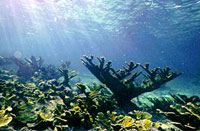 According to the World Conservation Union (IUCN), a conservation plan for the unregulated high seas - part of a UN-backed plan - will be produced by 2008, for adoption by world governments by 2012. According to the World Conservation Union (IUCN), a conservation plan for the unregulated high seas - part of a UN-backed plan - will be produced by 2008, for adoption by world governments by 2012.The attempt to bring the seas under greater control follows increasingly lawless acts, epitomized by Australia's dramatic 21-day chase in 2003 of a Uruguayan-flagged boat, which had been poaching the Patagonian toothfish - prized as a delicacy - in treacherous Antarctic seas. In addition, an IUCN report released October 25th, 2005 indicates that up to half of the world's coral reefs might be lost in the next 40 years unless urgent measures are taken to protect them. Of the 17 largest fisheries around the world, 15 are at either maximum exploitation levels or are depleting the level of their fish resource base - an unsustainable situation. Scientists say marine protected areas could help save coral reefs, for example by preventing the over fishing thatdecreases coral cover or preventing depletion of fish populations important for coral reef ecosystem. View the full October 26, 2005 Reuters article on Planet Ark View the October 25, 2005 IUCN report: Coral Reef Resilience and Resistance to Bleaching (PDF) Source: Reuters / Planet Ark |
|
| Manitoba Wildlands Releases 2005 Audit | 14 November 05 |
 On the heels of the 2005 Protected Areas Grade, Manitoba Wildlands has released its annual Protected Areas Audit. On the heels of the 2005 Protected Areas Grade, Manitoba Wildlands has released its annual Protected Areas Audit.Reflecting a failing grade for protected areas establishment over the past year, the 2005 audit does not show a significant increase in lands protected from development in the province of Manitoba in the past year. This year's audit shows an increase in protected lands of just 8021 ha. This brings the total area of protected land to 5,328,104 ha; 8.2% of the province's land base. Interim protection was extended for 3 park reserved, totaling 206,800 ha. Gaile Whelan Enns, director Manitoba Wildlands commented, "Like the Protected Areas Grade, the annual audit shows Manitoba is falling behind in fulfilling its protected area commitments. Our government needs to improve their protected areas data, and return to its former standard of access to protected areas information." The protected areas audit is based on government information in the public domain, primarily in the form of regulations and databases associated with certain Manitoba Acts that specify land use and land protection. View the Manitoba Wildlands' 2005 Protected Areas Audit (3mb PDF) Elements: View Manitoba Wildlands' 2005 Protected Areas Audit - Summary (PDF) View Manitoba Wildlands' 2005 Protected Areas Audit - Maps (PDF) View Manitoba Wildlands' 2005 Protected Areas Audit - Chart (PDF) View Manitoba Wildlands' 2005 Protected Areas Grade View Protected Areas Audits and Grades from previous years Source: Manitoba Wildlands |
|
| Groups Expose Hidden Road Network | 14 November 05 |
 More than 8,000 kilometres of logging roads criss-cross Ontario's Algonquin Provincial Park, hidden from public view, according to CPAWS-Wildlands and Sierra Legal Defence Fund. More than 8,000 kilometres of logging roads criss-cross Ontario's Algonquin Provincial Park, hidden from public view, according to CPAWS-Wildlands and Sierra Legal Defence Fund. The vast majority of the roads are used for logging, a use that doesn't belong in a park in the first place, according to the report. The groups assert that roads within the park, especially logging roads, are creating major problems for wildlife. The roads not only drive away species that previously existed in abundance but also bring in new species that out-compete native plants and animals for the same habitat. In comparison to Algonquin Park's 8,000 kilometres of roads, there are 5,300 kilometres of roads in Toronto and less than 6,000 kilometres of roads connecting Halifax to Vancouver. Nearly three quarters of the park is open to industrial logging activities and CPAWS-Wildlands and Sierra Legal Defence Fund are calling on the Government of Ontario to include Algonquin Park in the parks legislation. View the full October 17, 2005 press release on the Sierra Legal Defense Fund web site Sources: CPAWS-Wildlands and Sierra Legal Defence Fund |
|


 RSS Feeds:
RSS Feeds: